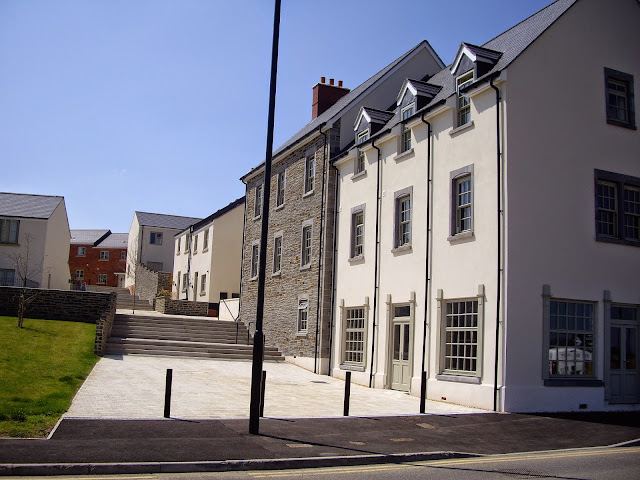From there we drove back into Swansea, past the new University buildings that, unfortunately, put me in the mind of Mussolini's EUR 42 in Rome. Except that quite possibly the EUR buildings were a better build quality....
Swansea seems to undergoing huge re-development, most of which looks regrettable. We paid a flying visit to the slightly underwhelming Dylan Thomas Centre housed in a splendid old building - the former Guildhall - near the docks. The exhibition was interesting, if a little too noisy when all the audio clips were playing at once. From there to the Promenade, and reminiscences of the Mumbles Train, and then swiftly on to 5 Cwmdonkin Drive, in the Uplands area of the city and the childhood home of Dylan Thomas.
Back down the hill to the The Guildhall, 1934, by Sir Percy Thomas. A huge brooding bulk of white Portland stone. A fortress of a building. A classical building where all the entablatures have been omitted giving each façade the look of a cliff The entrances are like the mouths of caves punched in the massive masonry. The windows almost seem incidental at times to the elemental feel. Each entrance is filled with a Bronze grille and door as though they had stepped out of ancient Rome. The whole thing is powerful confection of Imperial Rome, French Neo-classicism (Ledoux and Boulle) and Art Deco.
As you can see ornament is used sparingly - the Guildhall uses mass rather than ornament for effect - though there are a number of Art Deco-ish sculptures. Sir Robert Lorrimer developed a similar language of bare monumental wall contrasting with carefully placed ornament. Perhaps it would have benefited from the use of another stone, one with more personality than the even-grained Portland.
Inside there are civilized spaces and long corridors. The detailing is superb: bronze handrails end in the prows of Viking Long Boats commemorating the founders of the city. At the centre of this great hulk of a building nestles the Brangwyn Hall. This enormous concert Hall contains a series of great mural paintings by Sir Frank Brangwyn, each painted to resemble a tapestry. Known either as the 'Brangywn Panels' or the 'Empire Panels', they were painted by Brangwyn (1867-1956) as a celebration of the riches, both cultural and material, of the British Empire.
After lunch we headed north to Llandeilo Fawr and Dinefwr. Plas Dinefwr, also known as Newton House, is a property that has been rescued by the National Trust from near dereliction. The estate marks the political centre of the old Welsh Principality of Deheubarth. The current house was originally erected during the Restoration, and was surrounded by a Baroque garden and landscape. Unhappily these were swept away, and a landscape Park laid out by Capability Brown. The exterior of the house was eventually recast in Victorian High Gothic by Richard Kyrke Penson, whilst retaining the classical proportions of the original design.
The porte-cochere and the rather French tops to the corner towers are part of Penson's work. The interior was a bit of a disappointment. Firstly the interior had been wrecked by squatters, and secondly the Trust had decided to re-instate the interior as it would have been in the Edwardian Age. I think this was a mistake; I would have preferred the Trust had used an interior designer, someone say of the calibre of the late John Fowler, to create new interiors in a traditional taste.
At the rear of the house Penson added this remarkable porch and conservatory which certainly help break up the barrack like bulk of the house. (Walking around the outside I did think the whole thing a little institutional, as though it had once been an asylum.)
In the park I found these remarkable oak trees with their writhing, twisting roots.
Finally (!) we stopped briefly in Llandeilo Fawr and I took these. I need to return and explore some more.















Great to see some of my old stomping grounds. Swansea was a bit dire when I was there (2004-6) and I am glad it's being revived, but hope that it doesn't lose any remaining character.
ReplyDelete